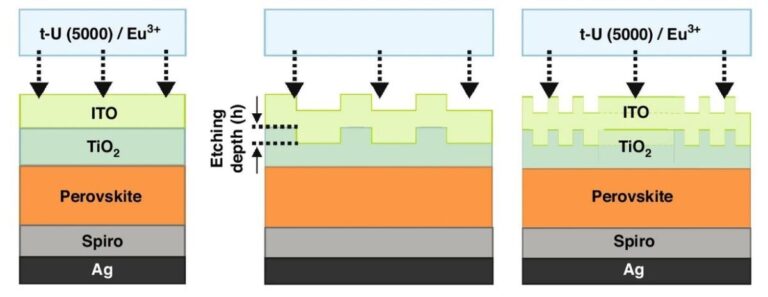Researchers in Portugal have adopted a new light-harvesting strategy to build ultra-thin perovskite solar cells that could reportedly have a longer operational lifespan. They used an LDS coating in combination with a photonic checkerboard structure to protect the cells from UV-induced degradation while enhancing UV radiation.
Researchers from Nova University of Lisbon in Portugal have developed an ultra-thin perovskite solar cell that uses a checkerboard (CB) tiling pattern with designated UV photon conversion capacity to protect the perovskite layer from UV-induced degradation and a luminescent, downward-shifting encapsulant that reportedly improves UV radiation.
They explained that UV degradation is one of the main factors causing the “irreversible” degradation of perovskites in solar cells, which usually occurs at the interface between the perovskite absorber and the electron transport layer (ETL). “This photostability problem can be easily solved if UV radiation does not reach the interface of ETL/perovskite layers,” she added. “However, the use of a UV-shielding encapsulant layer in perovskite solar cells will lose the UV photon from the solar spectrum, limiting further efficiency gains.”
The proposed combined solution was devised to solve this problem, as it acts not only as an encapsulant, but also as a “photon recycler” for the incident UV light. The addition of luminescent down-shifting (LDS) fluorophores to the encapsulant enables the conversion of high-energy photons into lower-energy photons. “These lower energy photons can then be absorbed by the perovskite layer without difficulty, and the increased number of visible photons available for absorption by the cell will in turn increase the external quantum efficiency (EQE) of the cell,” the group pointed out.
The team created checkerboard lattices (CB) with symmetry property to make them suitable for integration as an LT structure into the solar cells and then applied an LDS encapsulating material consisting of an experimentally developed tri-urea modified by lanthanides onto the CB -photonic front structure. .
The academics designed the solar cell with a substrate made of indium tin oxide (ITO), a titanium oxide (TiO2) ETL, a perovskite absorber, a hole transport layer (HTL) based on Spiro-OMeTAD, a silver (Ag) metal contact, and the proposed encapsulant with the CB photonic front structure. “The CB lattice structures are provided with a top coating as a final processing step, which prevents the structuring of the active absorber layer, which could lead to electrical degradation due to increased recombination,” they stated.
Using this architecture, they then built two solar cells with perovskite absorbers with a thickness of 250 nm and 500 nm, respectively. Tested under standard lighting conditions, the two devices achieved 25.9% and 28.2% higher photocurrent, respectively, compared to identical cells with a planar structure and without the new encapsulant and CB photonic front structure.
“We demonstrate that at least 94% of incident UV radiation can be effectively converted into the visible spectral range,” the research team said. “Photonic protection against high-energy photons contributes to the market introduction of perovskite solar cell technology and could become crucial for space applications under AM0 illumination.”
The new cell concept was explained in the paper “Photon shifting and capture in perovskite solar cells for improved efficiency and stability”, published in the scientific journal Light.
This content is copyrighted and may not be reused. If you would like to collaborate with us and reuse some of our content, please contact: editors@pv-magazine.com.


